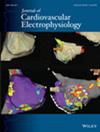Use of a Stylet Driven Lead With a Flexible Neck for Left Bundle Branch Area Pacing: A Single Center Experience
Abstract
Background
The majority of data on left bundle branch area pacing (LBBAP) are on a lumenless lead. Data on the safety and effectiveness of stylet driven leads are comparatively lacking.
Methods
We retrospectively analyzed 265 patients who underwent attempted LBBAP with an 7842 (Boston Scientific, Marlborough, MA) lead in the Duke University Health System between 1/1/2020 and 9/1/2023. Outcomes of interest included post-operative 7842 helix extension (≥2 helix rotations beyond the lead tip), complications, and lead parameters. A nested analysis of single and dual chamber LBBAP attempts was performed to compare outcomes among similar patients who underwent attempted LBBAP with the lumenless 3830 (Medtronic, Mineappolis, MN) lead.
Results
LBBAP success with 7842 was 89.8%. Characteristics were similar among patients with (n = 238) and without (n = 27) successful implants. Helix extension was evaluable for 222 of 238 successful 7842 implants. Of evaluable leads, helix extension was complete for 174 leads (78%), and partial for 48 (21.6%). A trend towards lower dislodgement rates was observed in patients with full versus partial extension (2.9% vs. 8.3%, p = 0.0895) and the rate of full helix extension increased over time (64.1% over 24 months vs. 81.4% over 21 months, p = 0.0162). The success rate of 3830 LBBAP implants (n = 140) was 92.8% (p = 0.069 vs. 7842). At implant, R waves were similar for 7842 and 3830 leads but were greater for 7842 during follow-up (14.4 + /−0.77 vs. 11.3 + /−0.68, p = 0.004). Pacing impedances were higher with 7842 compared with 3830 at baseline (838 + /−10.44 ohms vs. 772 + /−14.58 ohms, p < 0.001) and during follow-up (652 + /−11.0 ohms vs. 513 + /−9.18 ohms, p < 0.001); similarly, 7842 pacing thresholds (@ 0.4 ms) were slightly higher at baseline (0.85 V + /−0.03 vs. 0.68 V + /−0.03, p < 0.001) and 6 months (0.95 V + /−0.03 vs. 0.80 V + /−0.03, p < 0.001) compared with those for the lumenless 3830.
Conclusion
LBBAP implant success rates, complications, and pacing parameters using the 7842 lead are stable over time, and appeared overall similar to the 3830 lead. Incomplete 7842 helix extension is a modifiable risk factor for lead dislodgement.

 求助内容:
求助内容: 应助结果提醒方式:
应助结果提醒方式:


